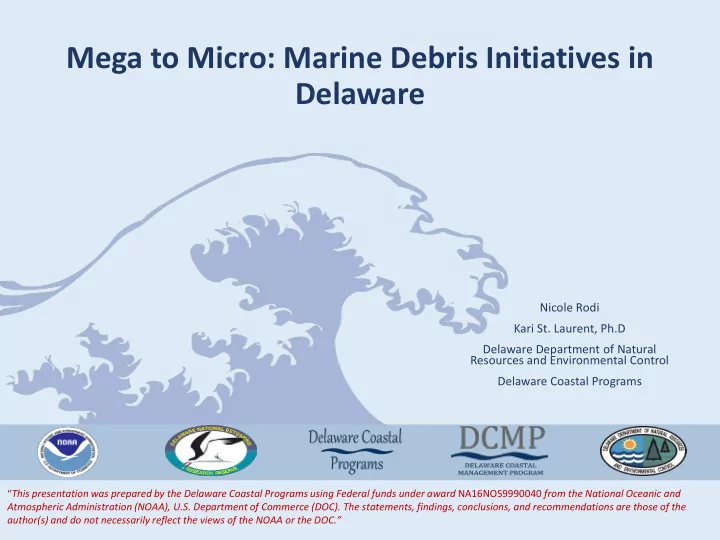

Mega to Micro: Marine Debris Initiatives in Delaware Nicole Rodi Kari St. Laurent, Ph.D Delaware Department of Natural Resources and Environmental Control Delaware Coastal Programs “ This presentation was prepared by the Delaware Coastal Programs using Federal funds under award NA16NOS9990040 from the National Oceanic and Atmospheric Administration (NOAA), U.S. Department of Commerce (DOC). The statements, findings, conclusions, and recommendations are those of the author(s) and do not necessarily reflect the views of the NOAA or the DOC.”
Mega Debris Identification • Identify mega debris using orthoimagery Woodland Beach State Wildlife Management Area • Ariel images flown in 2012 following Hurricane Sandy • Kent and Sussex County • Understanding emergency response needs after a large storm Delaware Maryland
Mega Debris Identification Debris Boats 7 Constructed Wood 32 Miscellaneous 63 Natural Wood 25 Total 127
Mega Debris Identification • Data went to the Division of Shoreline and Waterways • Currently working with Shoreline section to remove derelict debris items
Macro Debris Grappling the Invisible: a Derelict Crab Pot Removal Pilot Study in the Delaware Bay • Funded by the NOAA Marine Debris Program • Partnered with Stockton University
Grappling the Invisible Goals • Identification of pots in the target area • Comparing the efficiency and accuracy of the Klein 3900 to the Humminbird Helix 10 • Testing pot removal methods
Grappling the Invisible
Grappling the Invisible • 2017-2019 identified 792 targets with 85% confidence • 21nm x 0.3 nm (average LFP density = 125 targets/nm2) • Loss was observed in waters ranging from 2-5m depth.
Grappling the Invisible • Challenges • Deeper water • stronger currents • harder bottom types • icing events = target movement • Working with watermen as the State • Expanding into the Inland Scan 1- Mid-December • Bays to work with partners Scan 2- Mid- February • at DE Sea Grant and 175 total pots in the area • University of Delaware 77% of pots moved 3+ meters away •
Grappling the Invisible • Identification of pots in the target area • Comparing the efficiency and accuracy of the Klein 3900 to the Humminbird Helix 10 • Testing pot removal • Education and Outreach in the Inland methods Bays and lower Delaware Bay about properly rigging crab pots • Video on DNREC Environmental Perspectives Webpage called Crab Confidently
Microplastics: Sand and Water Optimize and establish a method that can cheaply and efficiently assess sand and water samples for microplastics in DE • Presence/absence data • Establish partnerships and collaborations to increase understanding • Expand into environmental education/ citizen science
Microplastics: Sand • NOAA funded program • Beaches sampled: Kitts Hummock, Ted Harvey, and Bowers Beach • Beaches that DNERR samples for HSC spawning • Microplastics present- predominantly beads and fibers • 30 samples from each beach collected winter 2019
Microplastics
Microplastics: Water • Water samples taken during nekton trawls in St. Jones River • Comparison between the St. Jones and Murderkill River • Partnering with University of Delaware
Microplastics: Delaware Bay April 2017 June 2017 • More plastic baywide in April than in June • More plastic upstream • Higher population densities • Estuarine Turbidity Maximum • Additional inputs around Dover (Murderkill and St. Jones Rivers) • Overall: unexpected spatial variability Dr. Jonathan H. Cohen Dr. Tobias Kukulka Anna Internicola Alan Mason
Microplastics: Delaware Bay • Baywide, fragments were the dominant microplastic type • Polyethylene (PE) and Polypropylene (PP) were most common • Sending DNREC samples for ATR FT-IR testing Dr. Jonathan H. Cohen, Anna Internicola, Dr. Tobias Kukulka, Alan Mason * Standards library: modified from Jung et al. (2018) Mar Poll Bull
Microplastics: Water DNERR Water Samples UD Water Sampling station Sand Samples New joint UD/DNERR Water sampling
Stories from Delaware Environmental Perspectives: Marine Debris Adrift at Sea
Recommend
More recommend